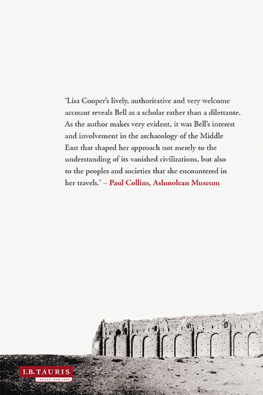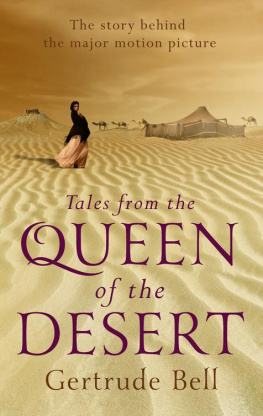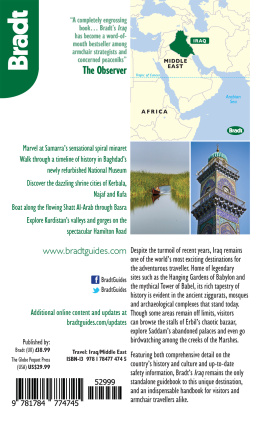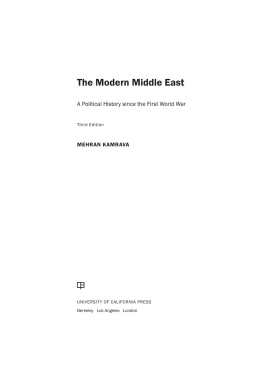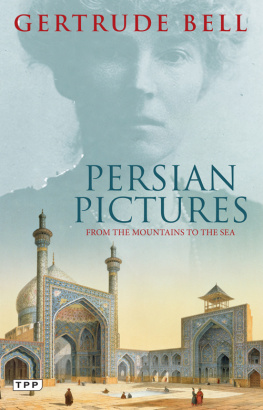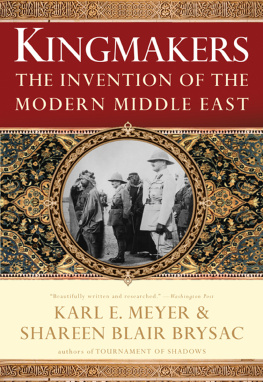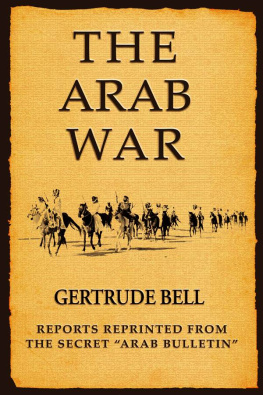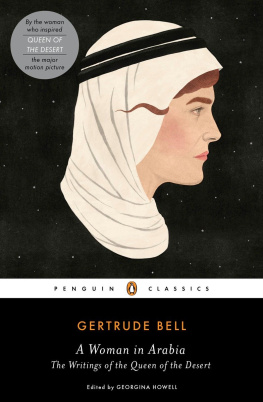
Lisa Cooper is Associate Professor of Near Eastern Art & Archaeology at the University of British Columbia. She is the author of Early Urbanism on the Syrian Euphrates.
Although Gertrude Bell has been a favourite subject for biographers, their focus on her travels, romances and political role has often overshadowed the significance of her archaeological work. Lisa Coopers lively, authoritative and very welcome account reveals Bell as a scholar rather than a dilettante. As the author makes very evident, it was Bells interest and involvement in the archaeology of the Middle East that shaped her approach not merely to the understanding of its vanished civilizations, but also to the peoples and societies that she encountered in her travels. This work situates Bell within a network of pioneering individuals that were transforming archaeology into a serious, scholarly discipline but this is far from a dry, academic survey of archaeological activity. Rather it brings us closer to understanding Gertrude Bells appreciation of Iraqs past, a vision that would inform her later activities in shaping the regions future.
Paul Collins, Jaleh Hearn Curator for Ancient Near East,
Ashmolean Museum
IN SEARCH OF KINGS
AND CONQUERORS
Gertrude Bell and the Archaeology of the
Middle East
L ISA C OOPER

Published in 2016 by
I.B.Tauris & Co. Ltd
London New York
www.ibtauris.com
Copyright 2016 Lisa Cooper
The right of Lisa Cooper to be identified as the author of this work has been asserted by the
author in accordance with the Copyright, Designs and Patents Act 1988.
All rights reserved. Except for brief quotations in a review, this book, or any part thereof, may not be
reproduced, stored in or introduced into a retrieval system, or transmitted, in any form or by
any means, electronic, mechanical, photocopying, recording or otherwise, without the prior written permission of the publisher.
Every attempt has been made to gain permission for the use of the images
in this book. Any omissions will be rectified in future editions.
References to websites were correct at the time of writing.
ISBN: 978 1 84885 498 7
eISBN: 978 0 85772 896 8
ePDF: 978 0 85772 805 0
A full CIP record for this book is available from the British Library
A full CIP record is available from the Library of Congress
Library of Congress Catalog Card Number: available
For Richard and Julianne:
Light of mine eyes and harvest of my heart
CONTENTS
LIST OF ILLUSTRATIONS
Gertrude Bell, taken around 1895, when she was about 26 years old. (PERS_A_005, courtesy of the Gertrude Bell Archive, Newcastle University.)
Bells 1905 photograph of the Arab castle of Shayzar (tenth to thirteenth centuries CE ). (Album B_190, courtesy of the Gertrude Bell Archive, Newcastle University.)
Bells photograph of the rock-cut tomb of Sextius Florentinus at Petra. (Album A_428, courtesy of the Gertrude Bell Archive, Newcastle University.)
Colonnade inside the precinct of the Temple of Bel, Palmyra (Syria). (Album A_300, courtesy of the Gertrude Bell Archive, Newcastle University.)
Gertrude Bell and her servant, Fattuh, standing in front of her tent at Ramsay and Bells camp at Binbirkilise (south central Turkey), in 1907. (Album H_239, courtesy of the Gertrude Bell Archive, Newcastle University.)
Bells photograph of several ruined Byzantine churches at Binbirkilise (south central Turkey). (Album H_128, courtesy of the Gertrude Bell Archive, Newcastle University.)
The ruined interior of Church No. 1 at Binbirkilise (fifth century CE ). (Album D_205, courtesy of the Gertrude Bell Archive, Newcastle University.)
Map of Bells 1909 Near Eastern journey. (Map prepared by Stephen Batiuk.)
David Hogarth traveller, archaeologist, author and political operative with T.E. Lawrence and Alan G.C. Dawnay. (Photograph by Lowell Jackson Thomas, courtesy of the National Portrait Gallery, London.)
Josef Strzygowski, the Polish-Austrian art historian. (Photograph courtesy of the Institut fr Kunstgeschichte der Universitt Wien.)
Bells photo of an intricately carved engaged collonnette and capital on the faade of the fourteenth-century al-Tawashi mosque, Aleppo. (Album J_078, courtesy of the Gertrude Bell Archive, Newcastle University.)
Bells photo of the Great Mosque in Aleppo. (Album J_053, courtesy of the Gertrude Bell Archive, Newcastle University.)
Bells photo of the inner faade of the doorway of the Khan al-Wazir, a seventeenth-century caravanserai in Aleppo. (Album J_061, courtesy of the Gertrude Bell Archive, Newcastle University.)
One of the stone fragments of a large stele from Tell Ahmar. (Album J_127, courtesy of the Gertrude Bell Archive, Newcastle University.)
A carved stone orthostat with the image of a winged, eagle-headed genius. (Album J_138, courtesy of the Gertrude Bell Archive, Newcastle University.)
A page from Bells field notebook. (Field Notebook GLB9, courtesy of the Royal Geographical Society, London.)
T.E. Lawrence and Leonard Woolley in 1913. (Photograph courtesy of the Trustees of the Liddell Hart Centre for Military Archives.)
Bells photo of the north tower tomb at Serrin, and the authors photograph of the same tower tomb in 2009. (Top: Album J_149, courtesy of the Gertrude Bell Archive, Newcastle University; bottom: photograph by Lisa Cooper.)
Bells photograph of the Water Gate at the site of Munbaqa (her Munbayah). (Album J_162, courtesy of the Gertrude Bell Archive, Newcastle University.)
Bells photo of the Islamic-period castle Qalat Jabbar. (Album J_169, courtesy of the Gertrude Bell Archive, Newcastle University.)
Bells 1909 detail of a baked brick faade above the gateway at the medieval castle of Qalat Jabbar. (Album J_168, courtesy of the Gertrude Bell Archive, Newcastle University.)
Author's photograph of the same feature shown in Fig. 2.14a. (Photograph by Lisa Cooper.)
Bells photograph of the square brick minaret from the ruin field of Raqqa. (Album J_181, courtesy of the Gertrude Bell Archive, Newcastle University.)
Bells photo of the impressive Baghdad Gate of Raqqa. (Album J_179, courtesy of the Gertrude Bell Archive, Newcastle University.)
The four-storey tower of the Qasr al-Banat, a twelfth-century elite residence at Raqqa. (Album J_180, courtesy of the Gertrude Bell Archive, Newcastle University.)
Deep triangular indentations of the tower shown in Fig. 2.17a. (Album J_183, courtesy of the Gertrude Bell Archive, Newcastle University.)
Bells photo of a room corner in the Qasr al-Banat. (Top: Album J_184, courtesy of the Gertrude Bell Archive, Newcastle University; bottom: photograph by Stephen Batiuk.)
Octagonal minaret of the twelfth century CE on the island of Anah, in the Euphrates River, present-day Iraq. (Album J_223, courtesy of the Gertrude Bell Archive, Newcastle University.)
Bells photo taken from the top of the minaret on the island of Anah. (Album J_232, courtesy of the Gertrude Bell Archive, Newcastle University.)
Shetateh, an oasis about four hours ride from Ukhaidir. (Album K_062, courtesy of the Gertrude Bell Archive, Newcastle University.)
Bells photograph of the site of Ukhaidir from the north-east. (Album K_078, courtesy of the Gertrude Bell Archive, Newcastle University.)
A page from Gertrude Bells field notebook, showing her sketch plan of the south-eastern sector of the Ukhaidir palace and her measurements. (Field Notebook GLB 11, Khethar 3, courtesy of the Royal Geographical Society.)
Next page
